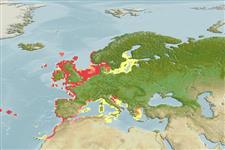Common names from other countries
>
Eupercaria/misc (Various families in series Eupercaria) >
Labridae (Wrasses)
Etymology: Symphodus: Greek, syn, symphysis = grown together + Greek, odous = teeth (Ref. 45335).
More on author: Linnaeus.
Environment: milieu / climate zone / depth range / distribution range
นิเวศวิทยา
เกี่ยวกับทะเล,น้ำเค็ม เกี่ยวกับหินโสโครก; ไม่มีการอพยพย้ายถิ่น, usually 1 - 30 m (Ref. 35388). Temperate; 63°N - 28°N, 32°W - 25°E
Eastern Atlantic: Norway to Morocco and the Azores. Also known from the western Mediterranean and Adriatic seas.
Length at first maturity / ขนาด / น้ำหนัก / Age
Maturity: Lm 8.5, range 7 - 10 cm
Max length : 28.0 cm SL เพศผู้/กระเทย; (Ref. 4742); common length : 20.0 cm SL เพศผู้/กระเทย; (Ref. 4742); อายุสูงสุดที่ได้รายงาน: 9 ปี (Ref. 4742)
เงี่ยงครีบหลัง (รวม) : 14 - 17; ก้านครีบอ่อนที่หาง (รวม) : 8 - 10; เงี่ยงครีบก้น: 3; ก้านครีบอ่อนที่ก้น: 8 - 11. A few cephalic pores (7-12) on snout. Lips with 5-7 folds. Scales on temporo-occipital surface 3-5 rows; on inter-operculum 2-3 (6-13) scales; on cheek 4-7; behind eye 1. A small dark spot on caudal peduncle. Often 5 large brown blotches near dorsal fin. Females and young: with numerous spots on body more or less longitudinally lined, some sinuous lines on head (Ref. 231). Coloration very variable; ground color of the male is greenish or blue while females are brownish to yellowish (Ref. 35388).
This schooling, territorial fish occurs in the littoral zone, near rocks and eel-grass beds, also in lagoons. In summer ripe females show short ovipositor. Seaweed nest built by male among rocks or in crevices. Sex reversal sometimes observed. Feed on mollusks, hydroids, bryozoans, worms and various crustaceans (Ref. 4742). Males grow faster than females (Ref. 4742). Oviparous, distinct pairing during breeding (Ref. 205).
Sex reversal sometimes observed. Seaweed nest built by male among rocks or in crevices (Ref. 4742). Oviparous, distinct pairing during breeding (Ref. 205).
Quignard, J.-P. and A. Pras, 1986. Labridae. p. 919-942. In P.J.P. Whitehead, M.-L. Bauchot, J.-C. Hureau, J. Nielsen and E. Tortonese (eds.) Fishes of the north-eastern Atlantic and the Mediterranean. UNESCO, Paris. Vol. 2. (Ref. 4742)
IUCN Red List Status (Ref. 130435)
CITES (Ref. 128078)
Not Evaluated
Threat to humans
Harmless
Human uses
การประมง: การประมงยังชีพ; การตกปลาเป็นกีฬา: ใช่; สถานที่แสดงสัตว์และพืชน้ำ: สถานแสดงสัตว์น้ำของรัฐ
เครื่องมือ
Special reports
Download XML
แหล่งที่มาจากอินเตอร์เน็ต
Estimates based on models
Preferred temperature (Ref.
115969): 8.8 - 17.2, mean 10.5 (based on 514 cells).
Phylogenetic diversity index (Ref.
82804): PD
50 = 0.5005 [Uniqueness, from 0.5 = low to 2.0 = high].
Bayesian length-weight: a=0.00871 (0.00572 - 0.01326), b=3.10 (2.98 - 3.22), in cm Total Length, based on LWR estimates for this species & Genus-body shape (Ref.
93245).
ระดับชั้นอาหาร (Ref.
69278): 3.4 ±0.1 se; based on diet studies.
ความสามารถในการกลับคืนสู่ปกติ (Ref.
120179): ขนาดกลาง, เวลาต่ำสุดที่จะทำให้ประชากรเพิ่มขึ้นเป็น 2 เท่าใช้เวลา 1.4 - 4.4 ปี (K=0.21-0.41; tm=2-3; tmax=9).
Fishing Vulnerability (Ref.
59153): Low to moderate vulnerability (34 of 100).
Climate Vulnerability (Ref.
125649): Moderate vulnerability (44 of 100).
